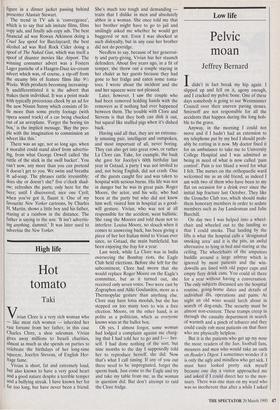Television
A dip in the swill bucket
Martyn Harris
It was only when I watched the British Television Advertising Awards this week (ITV, Monday, 10.40 p.m.) that I realised the Harry Enfield ads, which I've enjoyed for a year or more, were actually for Mer- cury Communications. Everyone has this kind of story, of the brilliant advert whose product has disappeared down the memory hole. It leads to the comfortable saloon-bar conviction that adverts don't really work, or if they do, then they don't work on me.
Of course they do — few things are more tightly monitored than the connection between advertising spend and product sales. What is uncertain is exactly how they get their results. I may have missed the loose link between Mercury phones and Enfield's 1950s-style ad, but now that idle curiosity has made me notice it — 'What is this advert about?' — it is probably lodged in my mind all the more firmly.
There is a standard piece of wisdom in advertising, attributed to various tycoons: `Half the money I spend on advertising is wasted. The trouble is I don't know which half.' All adverts above the level of old fashioned 'screamers' (like the man from Allied Carpets) are inherently convoluted and correspondingly expensive, which made them a natural training ground for what are now some of the leading Holly- wood directors: Alan Parker, Hugh Hud- son, Nicholas Roeg; Ridley and Tony Scott.
The Scott brothers were both inter- viewed for this programme — Tony in stu- dio mogul kit of big cigar, baseball cap and spectacles swinging from the neck of his T- shirt. Even for an expensive film like Top Gun, he explained, you were expected to shoot at the rate of 2.5 pages a day, or roughly 2 minutes 30 seconds of screen time, whereas he might get five days to shoot a single 30-second commercial for Saab. A feature film director might only get behind a camera once every 18 months so he needed the adverts, for practice as well as for money.
This was interesting, and well above the level of the usual awards show, with its Wogan/Edmonds clone at the podium and the ritual fussing over envelopes and trib- utes: 'And I'd like to thank my wife Teresa who stood by me throughout the Kat- tomeat commercial. . . . ' The only puzzle was why they bothered to site it at the Grosvenor House dinner at all, when all you saw of it was the occasional, unfocused
figure in a dinner jacket passing behind presenter Alastair Stewart.
The trend in TV ads is 'convergence', which is to say that ads imitate films, films copy ads, and finally ads copy ads. The best financial ad was Rowan Atkinson doing a Cruel Sea spoof for Barclaycard; the best alcohol ad was Red Rock Cider doing a spoof of The Naked Gun, which was itself a spoof of disaster movies like Airport. The winning consumer advert was a Fosters Lager pastiche of a Haagen-Dasz ice-cream advert which was, of course, a rip-off from the steamy bits of feature films like 91/2 Weeks. With products becoming increasing- ly undifferentiated it is the advert that makes them individual. It was a point made with typically precocious cheek by an ad for the new Nissan Sunny which consists of lit- tle more than some pretty footage (with opera sound track) of a car being chucked out of an aeroplane. 'Forget the boring tin box,' is the implicit message. 'Buy the peo- ple with the imagination to commission an advert like this.'
There was an age, not so long ago, when a moralist could stand aloof from advertis- ing, from what George Orwell called 'the rattle of the stick in the swill bucket'. You can't now, any more than you can pretend it doesn't get to you. We swim and breathe in ad-soup. The phrases rattle irresistibly: does she or doesn't she? five o'clock shad- ow; refreshes the parts; only here for the beer; until I discovered; nice one Cyril; when you've got it, flaunt it. One of my favourite New Yorker cartoons, by Charles H. Martin, shows a little boy and his father, staring at a rainbow in the distance. The father is saying to the son: 'It isn't advertis- ing anything, dammit.' It was later used to advertise the New Yorker.



























































 Previous page
Previous page